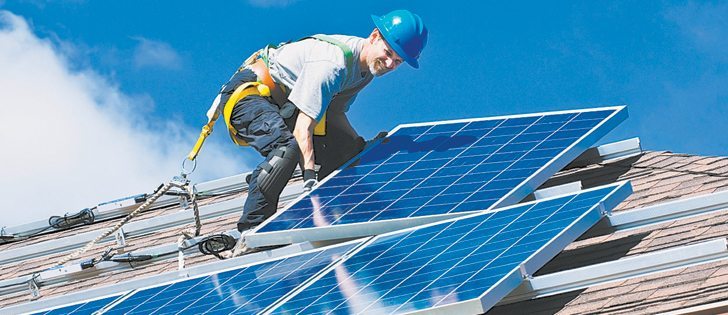Just as the wind can roar and then subside, so can the fortunes of the machines designed to capture its energy.
A few years ago, it seemed that wind had the edge over solar in kilowatt hours produced per dollar invested in residential projects. For Sask-atchewan, that resulted in a brief but intense love affair.
Saskatchewan was a testing ground for the two technologies, and for several years the province offered a rebate of 35 percent for installing grid-tied renewable energy systems of less than 100 kW capacity.
This included small-scale wind turbines and solar systems, and they comprised most of the eligible applications.
Hundreds of wind turbines and many fewer solar systems were installed under that rebate program, which ended in January 2012.
These systems were monitored by the Saskatchewan Research Council, which administered the rebate program.
All systems installed were grid-tied net-metering systems. Whatever was exported to the grid was subtracted from the power imported and the net amount billed back to the consumer.
Excess production from one part of the year could be credited for up to a year, so that good months of production could make up for later months of low production and higher consumption.
SaskPower, which is Saskatchewan’s sole power provider, metered the electricity entering and leaving the site, while the SRC was interested only in produced power. What it found was illuminating.
The wind turbine output from these smaller units was significantly lower than might have been expected from the specifications for the turbines and certainly lower than what the turbine owners anticipated.
There were a number of reasons for this gap, including the fact that some machines were out of commission for weeks or months, obviously eliminating production over that period.
Other problems included the related factors of turbine location and tower height.
Wind turbine output is site specific, with large variations possible from site to site because of wind speed and quality.
Wind power production is maximized when the wind flow is uninterrupted. Uneven terrain causes turbulence, which is why turbines located in water bodies are often the most productive.
Sharp slopes are also a problem, which is why big wind farms are located on ridges in gradually sloping landscapes.
Wind turbines, particularly the horizontal axis wind turbines that made up almost all of Saskatchewan’s small-scale installations, do not respond well to turbulent wind. This is why they need to be far away from objects creating the turbulence.
Turbulence results in less effective wind speed, lowers power production and causes unnecessary wear and tear. This increases the maintenance needed and contributes to machine failure.
The rule of thumb is that the wind turbine should be 100 to 150 metres from buildings and the lowest blade tip point should be 10 metres higher than surrounding objects, including buildings or trees.
Reducing wind speed by half reduces actual power output by a cube factor of that, which means a drop to one-eighth of the output. As a result, lost wind speed through poor siting or tower height is a costly error for the owner.
Many turbines in Saskatchewan that did not meet the distance re-quirements from turbulence-creating objects also did not meet the height requirement. As a result, significant potential power production was lost.
A lack of standardized testing for small wind turbines may have also been a factor, although that situation is changing. Turbine information came from manufacturers and might have included the best-case data or at worst, might have been deliberately misleading.
The small-scale wind industry has been an immature industry, and if this is true for manufacturers, then it would likely be the case for many sellers and installers as well.
It is also possible that some sellers did not really want to know more about wind so that they didn’t feel responsibility if the turbines failed to meet the anticipated energy production.
It’s also possible that buyers didn’t perform due diligence when doing their own research. Buyers needed to know enough to ask the hard questions to ensure that sellers were being straight with them.
Many of them didn’t know if the products they were buying were reliable and the tower sites appropriate.
There were individual turbines in Saskatchewan that did quite well, even in less-than-optimal locations.
However, small wind turbine production was generally disappointing. Unfortunately for the owners of those machines, power production will continue to be disappointing for the life of the turbines. In fact, some have been abandoned.
Production from some of them might be improved by relocating towers or placing turbines on higher towers, but those additional costs of re-installation might not be worth the extra power production.
In short, most Saskatchewan small-scale wind power producers did not find their production-to-cost ratio to be favourable.
The Saskatchewan rebate program also included solar installations, which on paper looked more expensive.
However, solar proved to be more reliable in many areas: actual output was much closer to the predictions, failures were few and maintenance was minimal.
In fact, analysis suggested that solar systems cost one-third of the wind systems when measured in kilowatt hour produced per dollar invested.
Solar systems were becoming more economical, to the point where solar installations costs dropped by at least 30 percent within the last year of the program.
Most installations were solar by the end of the program.
The conclusions from the Sask-atchewan experience are two-fold:
- Small-scale wind turbines do not make economic sense when compared with solar systems, with the exception of hybrid systems used in off-grid applications.
- Change occurs rapidly and no technology is the be-all and end-all.
It is important to note that economies of scale really do apply with wind turbines. The production-to-cost ratio is markedly more favourable for the giant turbines you see from the highways, many of which are up to 1,000 kW.
Sound decisions are based on current knowledge, and current knowledge tells us that the love of capturing energy through residential-sized wind turbines is a risk-laden and costly romance.
Will Oddie is a renewable energy, sustainable building consultant with a lifetime interest in energy conservation. To contact Oddie, send e-mail to energyfield@producer.com.




